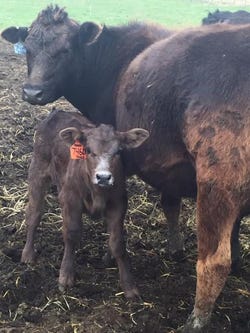3 considerations for creep feeding your calves this summer
April 28, 2016

You’ve got calves on the ground, things are greening up, and you’re itching to get pairs moved to summer pastures. It’s not only time to start thinking about fixing fence, checking waterers, testing herd bulls, branding, and making breeding decisions — it’s also time to consider whether or not you’ll creep feed calves this summer.
Glenn Selk, Oklahoma State University Emeritus Extension animal scientist, says that feed conversions of calves fed creep feed are quite variable and can range from the optimal 5:1 (5 pounds of grain consumed to 1 extra pound of calf weight) to the very poor 15:1 (or worse).
He offers three things to consider before filling the creep feeders this summer.
1. Lactation
 Selk writes, “Cows that give large amounts of milk to their calves will provide enough protein and energy to meet the growth potential of their calves. In that scenario, it is reasonable to assume that the feed conversion from creep feeding could be quite poor (10:1 or worse). If, however, the milk production of the cows is limited for any reason, then the added energy and protein from the creep feed provides needed nutrients to allow calves to reach closer to their genetic maximum capability for growth. Calves from poor milking cows may convert the creep feed at a rate of about 7 pounds of feed for each pound of additional calf weight.”
Selk writes, “Cows that give large amounts of milk to their calves will provide enough protein and energy to meet the growth potential of their calves. In that scenario, it is reasonable to assume that the feed conversion from creep feeding could be quite poor (10:1 or worse). If, however, the milk production of the cows is limited for any reason, then the added energy and protein from the creep feed provides needed nutrients to allow calves to reach closer to their genetic maximum capability for growth. Calves from poor milking cows may convert the creep feed at a rate of about 7 pounds of feed for each pound of additional calf weight.”
2. Drought
“Nutritional restriction due to drought situations often adversely affects milk production and therefore calf weaning weights,” says Selk. “Shortened hay supplies and reduced standing forage due to drought or severe winter weather often set the stage for the best results from creep feeding.”
3. Cost of gain
“As you are calculating the cost of creep feeds, remember to include the depreciation cost of the feeders and the delivery of the feed,” advises Selk. “Then of course, it is important to compare that cost of creep feeding to the realistic value of added gain. Although 500 pound steer calves may bring $1.80 per pound at the market, the value of added gain is currently about 80 cents per pound. Therefore, the estimated creep feeding cost per pound of added gain must be less than 80 cents for the practice to be projected to be profitable.”
Selk adds that creep feeding may be beneficial to calves from thin, young and less efficient cows rather than calves raised by mature, better conditioned cows producing more milk. Therefore, ranchers may conclude that some pastures will need creep feed and others might not.
Punch the numbers, be realistic in expected calf gains and weigh the pros and cons before filling the creep feeder this summer. With the uncertainty of the cattle markets, this decision could be more important this year than ever before.
The opinions of Amanda Radke are not necessarily those of beefmagazine.com or Penton Agriculture.
You might also like:
10 photo finalists celebrating spring
Burke Teichert: How to manage your way out of a hard-calving cowherd
2016 market outlook: Here's what to expect
You May Also Like



